The Test & Our Results
With the limited game support for the Hydra and our limited time with the new drivers, we’ve had to throw out most of our usual video card testing suite. What we have here are games that are on the approved list and are at least somewhat graphically challenging, but by no means is it a complete list. As FRAPS and the Hydra software do not currently get along, we’re limited to games with built-in frame counters. This is also the reason that we will be doing an in-depth look at the image quality of the Hydra after CES, when we have more time to come up with ways to take screenshots.
Unfortunately our testing today will only paint a limited picture. The Fuzion board does not have SLI support, which means we cannot test a pair of NVIDIA cards in SLI and use that as a baseline for N-Mode performance. We’re hoping to track someone down from MSI here at CES in order to explain why the Fuzion doesn’t have SLI support, as this is a major oversight for a high-end board. Whether NVIDIA was willing or not to license SLI to MSI for the Fuzion is going to be the single biggest question hanging over our heads. Update: We have since received an official response from MSI. They did not implement SLI support as they felt the performance with Hydra was close enough to make SLI support unnecessary. We still find this questionable.
For our performance testing, we used the following games: Call of Juarez (DX10 benchmark), HAWX, Resident Evil 5, Company of Heroes, and Batman: Arkham Asylum. Batman is not supported under X-Mode, so we’ll leave it out of X-Mode testing.
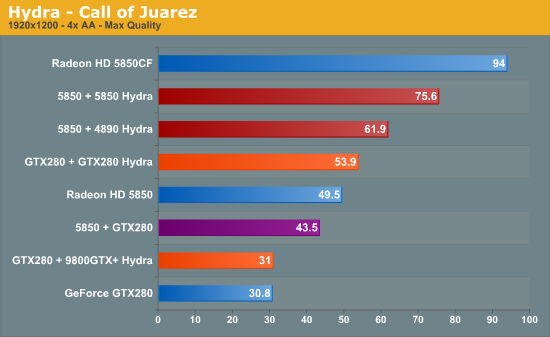
We’ll start with Call of Juarez, which is one of the Hydra’s better titles. With our 5850s in Crossfire, we get 94fps, which is just less than double the performance of a single 5850 (49.5). Right off the bat the Hydra takes a noticeable performance dive when using a pair of 5850s, splitting the difference between 1 and 2 cards with 75.6fps. Certainly it doesn’t look like Hydra can beat SLI/Crossfire, so it shouldn’t come as a surprise that Lucid and MSI aren’t claiming otherwise.
Moving to A-Mode with dissimilar video cards, we get some more definitive good news. Combining a 5850 and a 4890 gets us 61.9fps, a 25% performance improvement. This is less than the raw power of the 4890 (which is to say, in a perfect situation the 4890 performs at well more than 25% of a 5850) but it’s solid proof that this works.
As for the NVIDIA side, since we don’t have SLI results we’ll have to look at single-card and Hydra results. While 1 GTX280 gives us 30.8fps, a pair of them in N-Mode gives us 53.9, a 75% increase. This is much better than the increase we got on the 5850s, and much closer to the 100% theoretical max that we expect SLI is close to.
Switching to a GTX280 + 9800GTX+, things aren’t so rosy. The performance difference is practically absent at 0.2fps. While the Hydra technology scales worse the more mismatched a set of cards are, this is particularly awful.
Finally we have X-Mode using a 5850 + GTX280, with the AMD card as the master card. Here we get 43.5fps, which is slower than a single 5850. During this time we got significant microstuttering and striping in the image. Our best guess is that the Hydra was having trouble in the compositing phase, as the striping is a product of that. However in A-Mode and N-Mode we encountered no such issues. To the naked eye, Call of Juarez looked just as good in A-Mode and N-Mode as it does on a single video card.
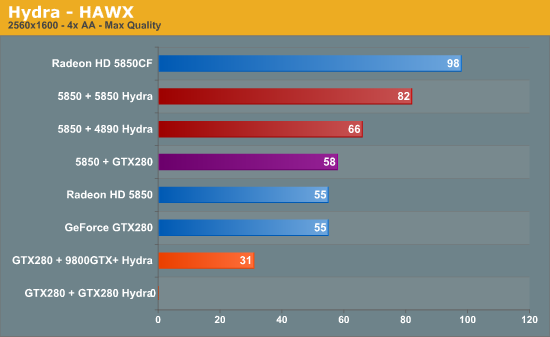
Moving to our old standby of HAWX, the picture is similar. Hydra performance on the 5850s is still below CF, but it’s still a 50% improvement. 5850 + 4890 is a 20% performance improvement. The GTX280s weren’t quite a success story however – HAWX crashed with a Lucid driver error when attempting to load the main menu of HAWX. Strangely the GTX280 + 9800GTX+ had no launch issues, rather the combination significantly underperformed the single GTX280 at -56%. Finally the 5850 + GTX280 came in at 58fps, which at a few fps faster than the lone 5850 is less than flattering.
Besides the single crash at no point did we see evidence of graphical corruption. HAWX always rendered correctly, even in X-Mode.
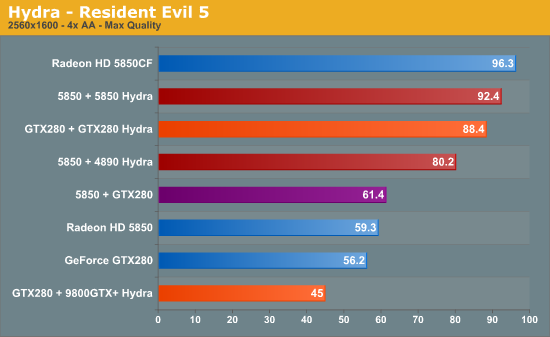
Resident Evil 5, in spite of being on the approved game list, was problematic for all Hydra modes. Every mode suffered from the same flickering problem (we suspect it’s lighting related), which doesn’t make the game unplayable but does make it annoying to play.
The performance however was very, very good. The 5850s got within 4% of CF mode, and the 5850 + 4890 still offered a solid 33% performance boost. The GTX280s did 57% better than a single GTX280, and the GTX280 + 9800GTX+ was the odd man out by losing performance. In X-Mode, the 5850 + GTX280 managed to squeak ahead of the single 5850 by 3.5%.
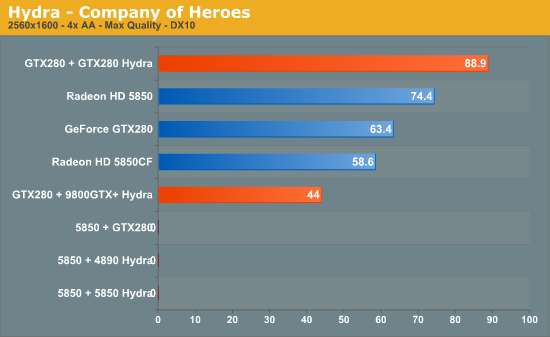
Company of Heroes is another game on the supported list that we didn’t have much luck with. There was no graphical corruption this time around, but instead it crashed on every mode involving an AMD card.
As for the NVIDIA cards, the GTX280s picked up about 30%, and the GTX280 + 9800GTX+ lost nearly the same 30%. There was no graphical corruption to report.
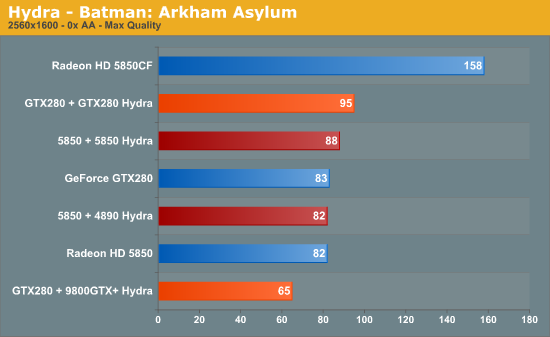
Finally we have Batman: Arkham Asylum, one of the most popular games of 2009. It doesn’t work in X-Mode, but does in N-Mode and A-Mode.
Unfortunately for the AMD cards, Lucid is having some scaling issues in A-Mode, something they do note in their release notes. A pair of 5850s is barely better than a single 5850, and a 5850 + 4890 flat-out isn’t better. The GTX280s pick up 15%, and the GTX280 + 9800GTX+ loses over 20%.
Frankly our testing experience was a mix of failures and successes, and this was sticking to the approved games list. Not a single game we picked to test worked perfectly in all cases, and the 1.4 driver release notes are a minefield of known issues. And unlike NVIDIA/AMD’s known issues, which tend to affect esoteric hardware and games, these are issues on what would be reasonably common high-end hardware configurations with popular games.
Here is by no means a complete list of games with known issues of graphical corruption: Call of Duty 4, World in Conflict (DX10), Rainbow Six Vegas 2, Operation Flashpoint Dragon Rising, Resident Evil 5. And as we’ve seen, this doesn’t include crashes, or undocumented graphical corruption.
We held off in doing significant testing on our Fuzion board until we had the 1.4 drivers in order to give Lucid time to get their next driver set out, since that set would be available when the hardware shipped. It was our hope in that moving from the 1.3 to 1.4 drivers that we’d see a reduction in graphical corruption compared to our tests in December when Lucid and MSI sent reps out, but that has not been the case.
This is by no means a complete list, and we aren’t going to claim otherwise. But in our testing thus-far, the Hydra drivers clearly need much more work. Frankly, we hesitate to think about what might have happened if the Fuzion shipped in November as originally announced.










47 Comments
View All Comments
liveonc - Tuesday, March 23, 2010 - link
Hydra is still pretty raw, but can it be the One Chip to rule them all, One Chip to find them, One Chip to bring them all and in the darkness bind them In the Land of Mordor where the Shadows lie? CPU, GPU, GPGPU wars comming to a standstill, where it doesn't matter if you use an Intel, AMD, Nvidia or Ati.Focher - Wednesday, January 13, 2010 - link
I think people should really give Lucid their due in regards to proving the underlying concept - that it is feasible to deliver mixed frame rendering in real time. Granted, the technology still seems immature but one has to remember that AMD and NVIDIA have both rejected the approach at this point.I'm still prepared to wait and see how the technology - and not just the current approach from Lucid - evolves. For example, perhaps AMD and NVIDIA will put some RnD efforts into multi-GPU cards that are better equipped at mixed frame rendering. Having it all on the same board could alleviate some of the bottlenecks.
Baron Fel - Sunday, January 10, 2010 - link
Crysis has a 91 at Metacritic and sold millions.Just wanted to point that out.
x86 64 - Saturday, January 9, 2010 - link
I thought the Hydra didn't do SLI\CF through software? I thought that was one of the main benefits of Hydra, no software profiles were needed. The preliminary results you guys posted are less than impressive. Not to sound like a pessimist but I figured it was too good to be true.Focher - Wednesday, January 13, 2010 - link
I think the term "profiles" isn't appropriate, as the review suggests it's more of a whitelist than any type of profile with customized settings for the specific game.prophet001 - Friday, January 8, 2010 - link
The implications of this technology are tremendous. I'm rather surprised at people brushing it off. It is fledgling and will obviously need some work but they will be able to do some really neat things once this matures. I'm thinking GPU farm via external PCI-E.hyvonen - Friday, January 8, 2010 - link
"We’ll start with Call of Juarez, which is one of the Hydra’s better titles. With our 5850s in Crossfire, we get 94fps, which is just less than double the performance of a single 5850 (49.5)."Don't mean "... we get 94fps, which is more than double the performance of a single 5850 (49.5)."
Or, on other words, WFT happened - how do you get more than double the performance with CF?!?!? Something got messed up in your test here, bro.
Veerappan - Friday, January 8, 2010 - link
Read it again... He's saying that the 94fps that they got is just slightly LESS THAN double 49.5 fps. So if a single 5850 gets 49.5 fps, double that is 99 fps.They got 94 fps, which is just a little bit less than 99.
jmurbank - Friday, January 8, 2010 - link
To me Lucid got something going but they should have done it differently. If they created the Hydra chip to be an on-board graphics chip and dispatcher, things will be different. Right now all they have is a dispatcher chip that uses a discrete graphics card to output video which makes it have multiple bottlenecks. It will be better if the Hydra output the graphics on on its own through its own display port while all the processing is done by the discrete graphics cards using stream processing technology like CAL (ATI) and CUDA (nVidia).Of course bad drivers screws up everything. Have look at ATI's history. ATI still makes poor software, but people do not mind. It seems people care more about performance than reliable and stable drivers. I care more about reliable and stable drivers, so it screws up my day if my computer crashes because of a driver.
beginner99 - Friday, January 8, 2010 - link
The worst thing you can do is promise stuff you can't deliver. it's sad. After these first benchmark, the tech will just have a bad reputation even if it will get better over time. Intel way would have been better. Just don't release it at all if it's an underperformer.I do see that it must we extremly complex to get this running at all. So it's actually quite an achievment but it's similar to cars. Combustion engines have been optimized during the last 100 years. No wonder no new technology can compete.
Maybe in 1-2 years this will be usable. If lucid is still alive then...Don't believe many will buy this board.
I also was rather suprised about CF. Used to be quite bad too as I remember? Probably due to a driver update? And how nows what nvidia or ATI is doing in there drivers. I assume they could put in stuff to cripple hydra on purpose.